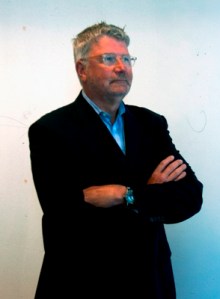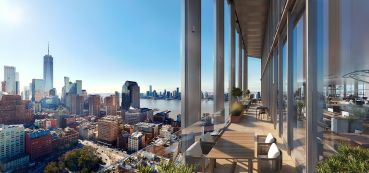Design in Mind: TPG Architecture’s Jim Phillips on the New Office Aesthetic
By Gus Delaporte September 10, 2013 9:00 am
reprintsJim Phillips, founder of New York’s largest interior architecture firm, TPG Architecture, boasts more than 40 years of experience designing corporate office interiors. The firm’s client list reads like a who’s who of New York power players, including Silverstein Properties, Irving Place Capital, Condé Nast, SL Green and Digitas. By Mr. Phillips estimation, he walks through more than 1 million square feet of office space in New York per year, which allows him a unique perspective on the city’s building stock. While architects might be best known for their build-out work, TPG and other architects begin the process well before work begins. Mr. Phillips’s services include advising clients on the suitability of space, negotiations and budgets, evaluating the entire deal. Mr. Phillips spoke with The Commercial Observer about changing trends, the evolving demands of clients and some of the difficulties he has faced when evaluating space.
 The Commercial Observer: We’ve heard a lot about trends such as sustainability and open-plan offices in recent years. Can you speak to how you have seen demands from clients evolve?
The Commercial Observer: We’ve heard a lot about trends such as sustainability and open-plan offices in recent years. Can you speak to how you have seen demands from clients evolve?
Mr. Phillips: I have spent the last 40 years of my career involved in workplace planning, and I have got to tell you today is the most exciting time with respect to workplace design. Why? Because you have so many choices—not either/or but both/and choices.
There’s no right way or wrong way for doing it. On one end is complete mobility, and on the other is having to come to work every day and being present and part of the culture. I think that’s pretty exciting in terms of choice. But the trends we see—clearly there is more and more of an emphasis on communal space, less on personal territory.
There is less hierarchy and more openness and transparency in the work environment and in business in general.
Are there exceptions to those trends? Are there any industries that have been slow to accept change?
The most traditional work environment has been the law firms, but they are changing or are talking about change. Driving the change is economic conditions. Law firms are facing the same conditions as the rest of the world post-2008. They all can’t bill on an hourly basis anymore. They are responding to RFPs and billing on a fixed basis. They are looking at ways to use the workplace in more effective and efficient ways.
When you meet with a client, what is your process?
We like to start by establishing an executive brief. What are the objectives? Then, we like to cultivate a project mission statement. The first step is developing a workplace strategy and a space program that is about the metrics. What is the need? We try to look forward into the future.
Once that’s defined and there is buy-in, the first major and important step is selecting a site. Leaseholds can costs hundreds of millions of dollars, and the build-out can be tens of millions. In many respects, the architect earns his fee in early stage when the sites are being selected.
With so many voices in the room, including architects, brokers and clients, does it always work smoothly?
It can get muddled, and it is our job to bring clarity to the voice so that we are singing the same song in the same key. The site selection process is one of comparative analysis. We assess how much space you need, what the capital costs are and what the hidden costs might be, so that in the end the client can make an informed decision.
There are often significant demands for infrastructure, particularly in the financial services industry. Does that limit the available building stock? If so, how do you deal with that?
I can think back to a project for a financial services firm moving from lower Manhattan to Midtown, and they viewed the move as reaffirmation of their commitment to New York.
A big consideration in the process was they wanted complete generation—a total redundancy for their business. We had to find physical places for generators and fuel oil tanks. That’s not an easy task to accomplish in many buildings, and that was the primary driver in building the selection. They ended up preleasing the building two years in advance of their needs to get the right space.
How hard is it to satisfy client demands? Do you find yourself having to temper expectations?
Finding perfection is pretty rare in life, so you try to find the asset and strength in a building and work with it. Sometimes, you need to work with a forest of columns or low ceiling heights, and you have to work around these and mitigate what is generally perceived as a negative. That doesn’t mean there can’t be viable alternatives.
Given evolving trends and technology, how have costs changed?
As technology has become more robust, infrastructure costs have gone up some. It’s interesting. One of the things that have changed is the geographic markets.
So much is driven by media and technology industries that don’t want to be in glass and steel skyscrapers. They want to be in cooler, funkier areas like Park Avenue South. They want older infrastructure ironically, and those buildings might require additional infrastructure, because they weren’t built to accommodate the needs of modern businesses.
How would you evaluate the new building stock set to come online in the city?
The new buildings today—they have a higher degree of quality than the spec office buildings going back historically. The new sites downtown and at Hudson Yards utilize world-class architects. Although none of it is complete, you would think it would make things easier, because the proper infrastructure is preplanned.
Is there a particular sector you feel TPG Architecture is best suited toward?
The two primary core competencies are office design, and the second-largest sector is retail design. I would say to you that, although we have strength in a number of sectors, advertising and media are particularly strong. We represent businesses in every sector that thrives here in New York.
I have always tried to take a business-minded view of the design process, and consequently I think it has led to an emphasis on the big-picture decisions and making those right decisions. We’ve made an effort to understand the physical inventory. There has always been an emphasis on the importance of real estate and the way we function
Thinking back on your career, was there a situation working with a client that presented particular difficulties for you?
We have done an advertising firm—a multiple-hundred-thousand-square-foot firm—which was out in advance of the market by a couple of years. They were looking to hit the market when they saw the potential of the market ascending, but it is very difficult to work the timing into a project schedule that is pretty linear.
There was an extraordinary effort made in terms of prelease activities, which resulted in tough negotiations. The lease for the tenant was drawn and then withdrawn, which was attributable to looking for space too far in advance.
That one deal fell through, but ultimately a deal got done. Ultimately, there was more time than the process needed. Deals need to ripen before people can take it seriously.


